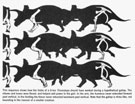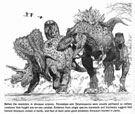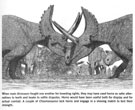Five fingers and four toes - all free. Fingers and toes bore large, flat hooves, except the outer two fingers (?-illustrations don't show a lack of nail on the outer fingers). Trackways indicate that the hands were separated by two hand widths from one another; hindfeet nearly touched midline. Limb joints are flexed, but somewhat less so as size increased. Probably could trot. Suspect slow gallop. Hind limbs were more robost than the front limbs and bore most of the weight.

Leg motion:
It's believed that the humerus which lies at an angle with the distal end pointing backwards, did not extend forward past vertical while galloping. It's believed that the femur did not flex past vertical.

Skin:
A reptilian mosaic of large scales surrounding even larger scales.
Behavior:
Trunk short - belief that they reared up on hind limbs, like bears, to intimidate predators (with head tilted forward) or reach choice food items. Tyrannosaurs' goal was to deliver a bite to the rear quarters, either by ambush or intimidating the ceratopsian into a chase.

They were believed to travel in herds due to evidence found in trackways. Some believe they may have formed circles, enclosing their young, when confronted with predators. This behavior is observed in Musk Oxen when confronted with a pack of Wolves. One illustration shows a sleeping arrangement in which the ceratopsians try to face all directions of possible attack.


